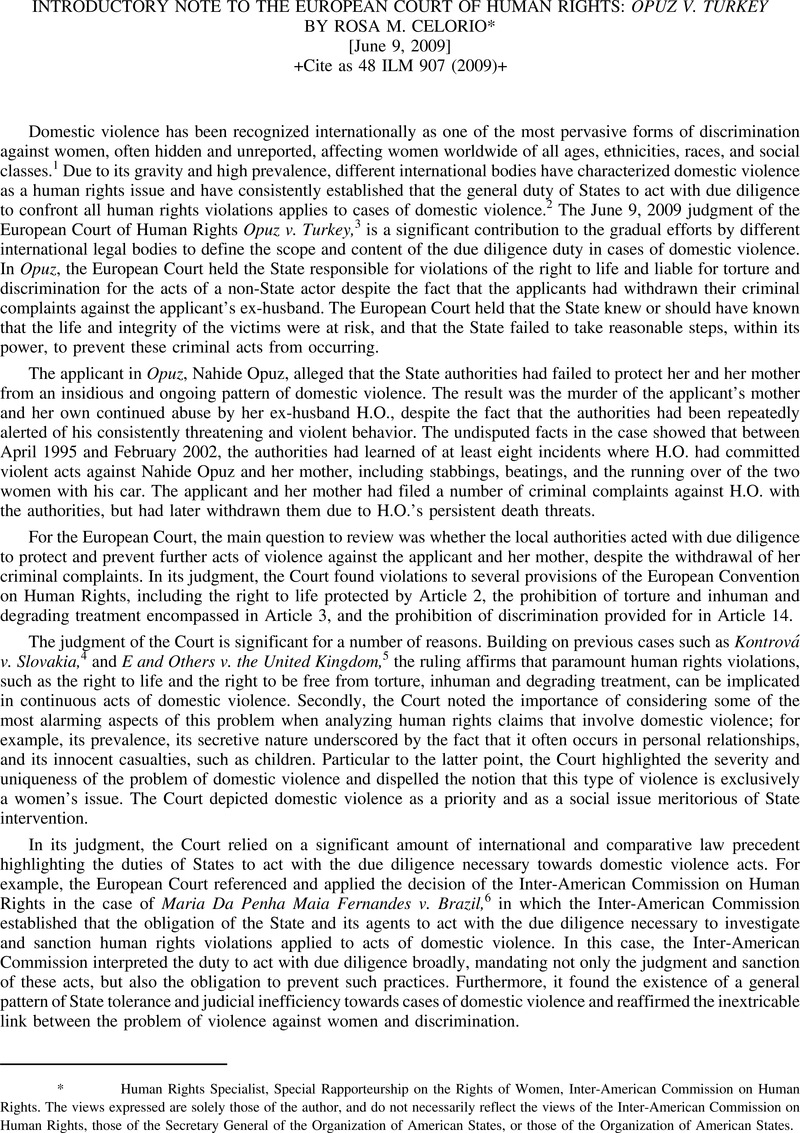No CrossRef data available.
Published online by Cambridge University Press: 27 February 2017

* Human Rights Specialist, Special Rapporteurship on the Rights of Women, Inter-American Commission on Human Rights. The views expressed are solely those of the author, and do not necessarily reflect the views of the Inter-American Commission on Human Rights, those of the Secretary General of the Organization of American States, or those of the Organization of American States.
* This text was reproduced and reformatted from the text available at the European Court of Human Rights website (visited October 1, 2009) <http://cmiskp.echr.coe.int/tkp197/view.asp?action=html&documentId=851046&portal=hbkm&source=externalbydocnumber&table=F69A27FD8FB86142BF01C1166DEA398649=.
1 See, e.g., The Secretary General, Report of the Secretary-General on In-Depth Study on All Forms of Violence against Women, ¶¶ 111-117, U.N. Doc. A/61/122/Add.1 (July 6, 2006); World Health Organization [WHO], Multi-Country Study on Women’s Health and Domestic Violence against Women, 1–10 (2005).
2 See, e.g., U.N. Commission on Human Rights, Special Rapporteur on Violence against Women, its Causes and Consequences, Report: The Due Diligence Standard as a Tool for the Elimination of Violence against Women, U.N. Doc. E/CN.4/2006/61 (Jan. 20, 2006); U.N. Committee on the Elimination of Discrimination against Women, General Recommendation 19, Violence against Women, ¶ 84, U.N. Doc. HRI/GEN/1//Rev.1 (1994); Maria Da Penha Maia Fernandes v. Brazil, Case No. 12.051, Report No. 54/01, Inter-Am. C.H.R., OEA/Ser.L/V/II.111 Doc. 20 rev. (2001) [hereinafter Fernandes v. Brazil]; Committee on the Elimination of Discrimination against Women; Views under Article 7 (3) of the Optional Protocol to the Convention on the Elimination of All Forms of Discrimination against Women, Communication No. 6/2005, Fatma Yildirim v. Austria (July 21, 2004); Communication No. 5/2005, Sahide Goekce v. Austria (July 21, 2004); and Communication No. 2/2003, A.T. v. Hungary (Jan. 26, 2005).
3 Opuz v. Turkey, App. No. 33401/02, Eur. Ct. H.R. (June 9, 2009).
4 Kontrová v. Slovakia, 2007-VI Eur. Ct. H.R.
5 E. and Others v. United Kingdom, App. No. 33218/96 Eur. Ct. H.R (Nov. 26, 2002).
6 Fernandes v. Brazil, supra note 2.
7 Osman v. United Kingdom, 1998-VII Eur. Ct. H.R. § 115- 116 (the European Court held that a State could only be held responsible for violations committed by private actors when it is shown that the State had knowledge of a situation of real and immediate risk and failed to adopt reasonable measures to prevent it).
8 Echoing the reasoning of the Inter-American Commission on Human Rights in Fernandes v. Brazil, supra note 2, the European Court referenced two reports submitted by non-governmental organizations, the Diyarbakir Bar Association and Amnesty International, to hold that the applicant was able to show that in Turkey domestic violence affected mainly women, and that the general and discriminatory inaction by the judiciary and the law enforcement agencies in Turkey, which perceived the problem as a family matter, created a climate that was conducive to domestic violence. See Opuz, ¶¶ 193-198.
1 On an unspecified date subsequent to the killing of her mother, the applicant obtained her divorce from her husband.
2 See the Committee’s General Recommendation No. 19 on ‘‘Violence Against Women,’’ (1992) UN doc. CEDAW/C/1992/L.1 /Add.15 at § 24 (a).
3 Ibid, at § 24 (b); see also § 24 (r).
4 Ibid, at § 24 (t).
5 Ibid, at § 24 (t) (i); see also paragraph 24 (r) on measures necessary to overcome family violence.
6 Velasquez-Rodriguez v. Honduras, judgment of July 29, 1988, Inter-Am. Ct. H.R. (ser. C) No. 4, para. 172.
7 Signed at the Inter-American Specialized Conference on Human Rights, San Jose, Costa Rica, 22 November 1969. Article (1) provides as follows: ‘‘1. The States Parties to this Convention undertake to respect the rights and freedoms recognized herein and to ensure to all persons subject to their jurisdiction the free and full exercise of those rights and freedoms, without any discrimination for reasons of race, color, sex, language, religion, political or other opinion, national or social origin, economic status, birth, or any other social condition. 2. For the purposes of this Convention, ‘person’ means every human being’’.
8 which was adopted by the Organisation of American States (OAS) and came into force on 5 March 1995.
9 Case 12.051, Report No. 54/01, Inter-Am. C>H.R., Annual Report 2000, OEA/Ser.L/V.II.111 Doc.20 rev. (2000)
10 Maria da Penha v. Brazil, §§ 55 and 56.